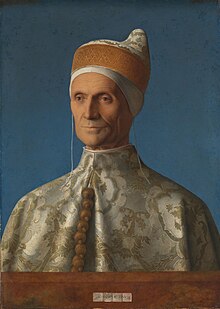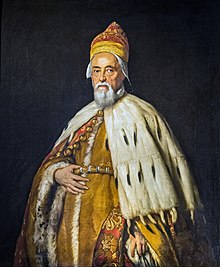
Quick Facts
Biography
The following is a list of all 120 of the Doges of Venice ordered by the dates of their reigns which are put in parentheses.
For more than 1,000 years, the chief magistrate and leader of the city of Venice and later of the Most Serene Republic of Venice was styled the Doge, a rare but not unique Italian title derived from the Latin Dux. Doges of Venice were elected for life by the city-state's aristocracy. Commonly the person selected as Doge was one of the shrewdest elders in the city. The Venetian combination of elaborate monarchic pomp and a republican (though "aristocratic") constitution with intricate checks and balances makes "La serenissima" (Venice) a textbook example of a crowned republic.
Despite the great power given to them, the Venetian Doges were restricted by law (unlike the Doges of the Republic of Genoa) to spend the rest of their lives inside the Doge's Palace complex and St Mark's Basilica, occasionally leaving for diplomatic reasons.
7th century
- Paolo Lucio Anafesto (697–717) first doge (Latin: dux), dependent on the Exarchate of Ravenna
8th century
- Marcello Tegalliano (717–726)
- Orso Ipato (726–737) nominated by the popular assembly opposed to the iconoclast policies of the Byzantine Emperor; murdered by rebels during a civil conflict
Brief Interregnum (737–742) of duke magistrate equivalents (Latin: magister militum)
- Dominicus Leo Abrogatis (737)
- Felice Cornicola (738)
- Teodato Ipato (739)
- Gioviano Cepanico Ipato (740)
- Giovanni Fabriciaco (741)
Resumption of Office of Doge
- Teodato Ipato (742–755) deposed, blinded, and exiled
- Galla Gaulo (755–756) deposed, blinded, and exiled
- Domenico Monegario (756–764) deposed, blinded, and exiled
- Maurizio Galbaio (764–787)
- Giovanni Galbaio (787–804) fled to Mantua in 803 with family, where they all probably died
9th century
- Obelerio Antenoreo (804–811) exiled, attempted to return to power, killed & head displayed in the market
- Agnello Participazio (811–827)
- Giustiniano Participazio (827–829)
- Giovanni I Participazio (829–837) arrested, and tonsured (head shaved like monk)
- Pietro Tradonico (837–864) assassinated, although in this case his successor arrested and executed the assassins
- Orso I Participazio (864–881)
- Giovanni II Participazio (881–887) resigned due to poor health
- Pietro I Candiano (887–888) killed in open battle while invading the Narentines
- Pietro Tribuno (888–912)
10th century

- Orso II Participazio (912–932)
- Pietro II Candiano (932–939)
- Pietro Participazio (939–942)
- Pietro III Candiano (942–959)
- Pietro IV Candiano (959–976) people of Venice locked him in palace with son while it burned
- Pietro I Orseolo (976–978) resigned to become a Camaldolese hermit in the Abbey of Saint-Michel-de-Cuxa in the Pyrenees
- Vitale Candiano (978–979) abdicated, for health reasons
- Tribuno Memmo (979–991)
- Pietro II Orseolo (991–1009)
11th century
- Otto Orseolo (1009–1026) arrested, beard shaved, and banished to Constantinople for nepotism. He was the father of Peter Orseolo, King of Hungary.
- Pietro Barbolano (1026–1032) abdicated under heavy pressure to reinstate Otto Orseolo
- Domenico Flabanico (1032–1043)
- Domenico Contarini (1043–1071)
- Domenico Selvo (1071–1084) deposed peacefully to a monastery because of naval defeat, died three years later
- Vitale Faliero (1084–1096)
- Vitale I Michiel (1096–1102)
12th century

- Ordelafo Faliero (1102–1117)
- Domenico Michele (1117–1130)
- Pietro Polani (1130–1148)
- Domenico Morosini (1148–1156)
- Vital II Michele (1156–1172)
- Sebastiano Ziani (1172–1178)
- Orio Mastropiero (1178–1192)
- Enrico Dandolo (1192–1205)
13th century
- Pietro Ziani (1205–1229)
- Jacopo Tiepolo (1229–1249)
- Marino Morosini (1249–1252)
- Reniero Zeno (1252–1268)
- Lorenzo Tiepolo (1268–1275)
- Jacopo Contarini (1275–1280)
- Giovanni Dandolo (1280–1289)
- Pietro Gradenigo (1289–1311)
14th century

- Marino Zorzi (1311–1312)
- Giovanni Soranzo (1312–1328)
- Francesco Dandolo (1328–1339)
- Bartolomeo Gradenigo (1339–1342)
- Andrea Dandolo (1342–1354)
- Marino Faliero (1354–1355) – convicted of treason, executed and condemned to damnatio memoriae
- Giovanni Gradenigo (1355–1356)
- Giovanni Dolfin (1356–1361)
- Lorenzo Celsi (1361–1365)
- Marco Cornaro (1365–1367)
- Andrea Contarini (1367–1382)
- Michele Morosini (1382–1382)
- Antonio Venier (1382–1400)
- Michele Steno (1400–1413)
15th century
- Tommaso Mocenigo (1413–1423)
- Francesco Foscari (1423–1457) – forced to abdicate by the Council of Ten
- Pasquale Malipiero (1457–1462)
- Cristoforo Moro (1462–1471)
- Nicolò Tron (1471–1473)
- Nicolò Marcello (1473–1474)
- Pietro Mocenigo (1474–1476)
- Andrea Vendramin (1476–1478)
- Giovanni Mocenigo (1478–1485)
- Marco Barbarigo (1485–1486)
- Agostino Barbarigo (1486–1501)
16th century


- Leonardo Loredan (1501–1521)
- Antonio Grimani (1521–1523)
- Andrea Gritti (1523–1538)
- Pietro Lando (1538–1545)
- Francesco Donato (1545–1553)
- Marcantonio Trivisan (1553–1554)
- Francesco Venier (1554–1556)
- Lorenzo Priuli (1556–1559)
- Girolamo Priuli (1559–1567)
- Pietro Loredan (1567–1570)
- Alvise I Mocenigo (1570–1577)
- Sebastiano Venier (1577–1578)
- Nicolò da Ponte (1578–1585)
- Pasqual Cicogna (1585–1595)
- Marino Grimani (1595–1606)
17th century

- Leonardo Donato (1606–1612)
- Marcantonio Memmo (1612–1615)
- Giovanni Bembo (1615–1618)
- Nicolò Donato (1618–1618)
- Antonio Priuli (1618–1623)
- Francesco Contarini (1623–1624)
- Giovanni I Cornaro (1624–1630)
- Nicolò Contarini (1630–1631)
- Francesco Erizzo (1631–1646)
- Francesco Molin (1646–1655)
- Carlo Contarini (1655–1656)
- Francesco Cornaro (1656–1656)
- Bertuccio Valiero (1656–1658)
- Giovanni Pesaro (1658–1659)
- Domenico II Contarini (1659–1674)
- Nicolò Sagredo (1674–1676)
- Alvise Contarini (1676–1683)
- Marcantonio Giustinian (1683–1688)
- Francesco Morosini (1688–1694)
- Silvestro Valiero (1694–1700)
- Alvise II Mocenigo (1700–1709)
18th century

- Giovanni II Cornaro (1709–1722)
- Sebastiano Mocenigo (1722–1732)
- Carlo Ruzzini (1732–1735)
- Alvise Pisani (1735–1741)
- Pietro Grimani (1741–1752)
- Francesco Loredan (1752–1762)
- Marco Foscarini (1762–1763)
- Alvise Giovanni Mocenigo (1763–1779)
- Paolo Renier (1779–1789)
- Ludovico Manin (1789–1797) – forced to abdicate by Napoleon
The Position of Doge was abolished; instead the position of Podestà of Venice were appointed since 1806 to 1866 by the rulers of the city during the early- to mid-19th century: Napoleon and the Habsburgs. In 1860, the nascent Kingdom of Italy created the office of the Mayor of Venice (Sindaco di Venezia), chosen by the City council. From 1946 to 1993, the Mayor of Venice was chosen by the City Council. Since 1993, under provisions of new local administration law, the Mayor of Venice is chosen by popular election, originally every four, and later every five years:
